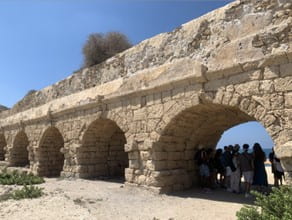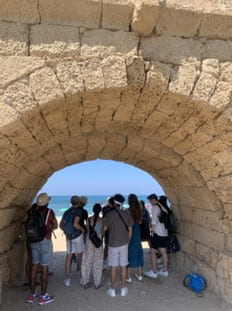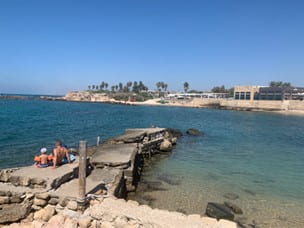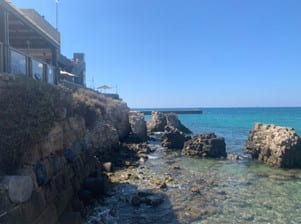Aqueduct and ancient water supply and water management
By Emilia McDougal, Alex Perry, Nikhil Sriram
Today our group headed an hour north of Tel Aviv to visit Caesarea, a historic seaport and current national park bordering the Mediterranean Sea. Originally founded by Herod the Great around 20 BCE, the site has seen generations of inhabitants, from Muslims displaced by the Ottoman Empire to various groups of Crusaders who came from Europe with the goal of conquering holy sites.
Two impressive engineering feats that mark the remnants of the town and its history are an aqueduct more than two centuries old and an artificial seaport estimated to be from around the same time. Professors George Wells and Elie Rekhess gave us a tour of both.

The aqueduct pictured above, whose water originated from a stream over five kilometers from the actual town, was created from a cement mixture that contained volcanic ash, an ingredient to which material scientists attribute the longevity of the structures. Running from the north to the south, the structure is estimated to have carried amounts of water comparable to modern-day cities to its citizens. Though currently uncovered, when in use, engineers would use stone slabs to cover the tops of the water so as not to leave it exposed to the elements and allow for its contamination. We learned there are two methods to induce water flow: gravity and differences in pressure. An aqueduct has a subtle slope to it, using gravity to transfer the water over great distances. Ancient engineers had the difficult job of determining which degree of the slope was small enough so that the aqueduct wouldn’t reach the ground before traveling to the necessary destination, while also being steep enough to overcome friction. Another impressive aspect of the aqueducts was the use of arches as supports. The purpose of an arch shape is that instead of using vertical supports, where gravity pulls the load directly downwards with no load bearing in between supports, the load is distributed in a more diagonal direction with arches. The aqueduct is now a popular beach spot where tourists and locals alike relax under the arches once used to supply fresh water. Our group is pictured below, finding a moment of respite from the intense desert sun beneath the shade of the aqueduct.

The second engineering feat, an artificial sea harbor, is located within the heart of Caesarea and was built around 22 to 15 BC. It was the largest artificial harbor of that time and is featured in the two pictures below. The historical importance of this site stems from its strategic positioning as a midpoint of the contested land in modern-day Israel, as whoever controlled this land denied others the opportunity to unite the areas above and below. Additionally, having the town as a seaport allowed for a local community to thrive in an economy driven by merchants, commerce, and fishermen. The “glue” used for constructing this harbor and keeping stones together was formed of volcanic ash mixed with limestone and water. The volcanic ash was brought in from Italy, making the construction of this artificial harbor all the more impressive.


We concluded the planned activities with a group meal. One of the popular dishes is pictured below. Lentils are a very common source of protein in the region, and on top of the dish, it is customary to add some greek yogurt and sliced cucumbers, showing the Mediterranean influence in dishes. After the meal, we headed back to our hostel and were given free time to explore and rest before our next day of activities.

The Global Engineering Trek (GET) to Israel is jointly organized by the Northwestern Center for Water Research (NCWR) and the Israel Innovation Project (IIP). This program is focused on the topic of water (GET Water-Israel) and is offered to all first- and second-year Northwestern undergraduate students. GET Water-Israel is co-sponsored by McCormick Global Initiatives, the Institute for Sustainability and Energy at Northwestern (ISEN), the Crown Family Center for Jewish and Israel Studies, NCWR, and IIP.

